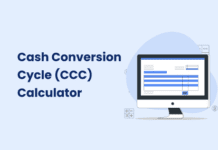In today’s uncertain cash flow environment, tracking how quickly your business collects payments isn’t just smart—it’s essential. That’s where the Days Sales Outstanding (DSO) metric comes into play.
To simplify DSO tracking and benchmarking, we’ve created a free, easy-to-use DSO Calculator Template that helps you:
- Calculate monthly or yearly DSO
- Visualize trends across months
- Compare performance against industry medians
What Is Days Sales Outstanding (DSO)?
DSO is a key metric that tells you how many days, on average, it takes for your business to collect payment after a sale is made. It reflects the effectiveness of your accounts receivable process and credit control policy.
DSO Formula:
DSO = (Accounts Receivables ÷ Total Sales) × Number of Days
A high DSO may indicate inefficient collection processes or lax credit policies, while a low DSO suggests effective credit management and faster cash inflows.
What’s Inside the DSO Calculator Template?
Our template includes two powerful sections for measuring and tracking DSO over time:
1. Quick DSO Calculator
Easily calculate DSO for any period using three inputs:
- Total Accounts Receivable Outstanding
- Total Sales for the same period
- Number of Days in that period
Once entered, the template auto-calculates your DSO. Ideal for one-off calculations—monthly, quarterly, or annually.
2. Monthly DSO Tracker
The monthly format helps identify:
- Seasonal spikes in receivables
- Periods where collections slow down
- Trends that affect working capital
Benchmark: How Does Your DSO Compare to Industry Averages?
To make the template more insightful, we’ve also included a DSO Medians by Industry Group reference sheet based on CRF’s 2020 report.
For example:
- Apparel & Textile: 63.99 days
- Food Products: 24.66 days
- Business Services: 37.84 days
- Industrial Machinery: 43.18 days
- Leather Products: 64.4 days
📌 Use this to benchmark your business performance and evaluate if your collection cycle is healthy compared to peers.
Why DSO Matters to Finance Teams
- Cash Flow Optimization: DSO directly impacts how much working capital is tied up in receivables.
- Credit Policy Assessment: High DSO may highlight overly lenient credit terms or collection delays.
- Investor Confidence: Strong DSO performance signals operational efficiency to stakeholders.
- Planning & Forecasting: Understanding DSO helps improve accuracy in cash flow planning.
How to Use the DSO Calculator Template
- Download the template in Excel or Google Sheets.
- Start with the quick calculator for instant insights.
- Use the monthly tracker to log DSO across months.
- Benchmark using the provided industry medians.
- Share the insights with your finance team or CFO.
Ready to Transform Your AP Process?
Manual payables tracking can hold your finance team back. With Peakflo, you can automate invoice approvals, avoid late payments, and extend DPO without hurting vendor trust. 📞 Book a free demo with Peakflo to see how we help companies reduce manual effort, gain real-time visibility, and optimize working capital.









![Why AI Sales Calls Are Making Good Sales Reps Even Better [2025 Guide] ai sales calls](https://cdn-kmjmp.nitrocdn.com/YvtqmrsiHUxqerlSiZgbfzqqTARWTElr/assets/images/optimized/rev-834053b/blog.peakflo.co/wp-content/uploads/2025/09/65168cf6-3001-4733-8cbc-12d5684cf449-218x150.webp)

































